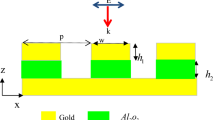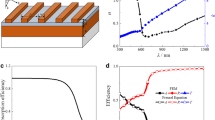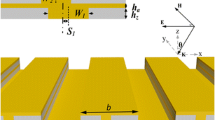Abstract
Dual-band light absorption with the maximal absorptivity up to 99.7% and the minimal spectral bandwidth down to 3 nm is obtained in the plasmonic absorbers consisting of triple-layer plasmonic crystal-nonlinear medium cavity-metal substrate structure, where the intercalated dielectric material is chosen to be a Kerr medium cavity. Efficient all-optical controlling with high spectral intensity change ratios and detecting signal-to-noise is achieved for the system after a slight increase of pumping intensity. These impressive results mainly result from the strong plasmonic resonant field confinement in the middle nonlinear Kerr medium cavity and the near-perfect relative intensity change response by the ultra-sharp anti-reflection spectrum. This work can lay a foundation for advanced all-optical devices by exploiting light perfect absorption behavior and resonant optical field enhancement.




Similar content being viewed by others
References
Liu W, Li M, Guzzon R, Norberg E, Parker J, Lu M, Coldren L, Yao J (2016) A fully reconfigurable photonic integrated signal processor. Nat Photonics 10:190–195
Hu X, Jiang P, Ding C, Yang H, Gong Q (2008) Picosecond and low-power all-optical switching based on an organic photonic-bandgap microcavity. Nat Photonics 2:185–189
Chen S, Liu J, Lu H, Zhu Y (2013) All-optical strong coupling switches based on a coupled meta-atom and MIM nanocavity configuration. Plasmonics 8:1439–1444
Wang H, Goorskey D, Xiao M (2002) Controlling light by light with three-level atoms inside an optical cavity. Opt Lett 27:1354–1356
Li C, Xin J, Tang D, Hao F (2015) Control of group velocity based on nonlinear Kerr effect in a plasmonic superlattice. Plasmonics 10:1593–1596
Li J, Tao J, Chen Z, Huang X (2016) All-optical controlling based on nonlinear graphene plasmonic waveguides. Opt Express 24:22169–22176
Liu G, Deng H, Li G, Chen L, Dai Q, Lan S, Tie S (2014) Nonlinear optical properties of large-sized gold nanorods. Plasmonics 9:1471–1480
Zheng Y, Yu Q, Tao K, Ouyang Z (2013) All-optical tunable filters based on optomechanical effects in two-dimensional photonic crystal cavities. Opt Lett 38:4362–4365
Lin X, Yan J, Wu L, Lan S (2008) High transmission contrast for single resonator based all-optical diodes with pump-assisting. Opt Express 16:20949–20954
Min C, Wang P, Chen C, Deng Y, Lu Y, Ming H, Ning T, Zhou Y, Yang G (2008) All-optical switching in subwavelength metallic grating structure containing nonlinear optical materials. Opt Lett 33:869–871
Abb M, Albella P, Aizpurua J, Muskens Otto L (2011) All-optical control of a single plasmonic nanoantenna–ITO hybrid. Nano Lett 11:2457–2463
Fang M, Shi F, Chen Y (2016) Unidirectional all-optical absorption switch based on optical Tamm state in nonlinear plasmonic waveguide. Plasmonics 11:197–203
Zhong Z, Xu Y, Lan S, Dai Q, Wu L (2010) Sharp and asymmetric transmission response in metal-dielectric-metal plasmonic waveguides containing Kerr nonlinear media. Opt Express 18:79–86
Tao J, Wang QJ, Huang XG (2011) All-optical plasmonic switches based on coupled nano-disk cavity structures containing nonlinear material. Plasmonics 6:753–759
Watts CM, Liu XL, Padilla WJ (2012) Metamaterial electromagnetic wave absorbers. Adv Mater 24:OP98–OP120
Cui Y, He Y, Jin Y, Ding F, Yang L, Ye Y, Zhong S, Lin Y, He S (2014) Plasmonic and metamaterial structures as electromagnetic absorbers. Laser & Photon Rev 8:495–520
Aydin K, Ferry VE, Briggs RM, Atwater HA (2011) Broadband polarization-independent resonant light absorption using ultrathin plasmonic super absorber. Nat Commun 2:517
Liu Z, Liu X, Huang S, Pan P, Chen J, Liu G, Gu G (2015) Automatically acquired broadband plasmonic-metamaterial black absorber during the metallic film-formation. ACS Appl Mater Interfaces 7:4962–4968
Zhong YK, Fu SM, Tu MH, Chen BR, Lin A (2016) A multimetal broadband metamaterial perfect absorber with compact dimension. IEEE Photonics Journal 8:6801810
Bruck R, Muskens Otto L (2013) Plasmonic nanoantennas as integrated coherent perfect absorbers on SOI waveguides for modulators and all-optical switches. Opt Express 21:27652–27661
Li W, Valentine J (2014) Metamaterial perfect absorber based hot electron photodetection. Nano Lett 14:3510–3514
Chen X, Chen Y, Yan M, Qiu M (2012) Nanosecond photothermal effects in plasmonic nanostructures. ACS Nano 6:2550–2557
He J, Ding P, Wang J, Fan C, Liang E (2015) Ultra-narrow band perfect absorbers based on plasmonic analog of electromagnetically induced absorption. Opt Express 23:6083–6091
Fang Z, Zhen Y, Fan L, Zhu X, Nordlander P (2012) Tunable wide-angle plasmonic perfect absorber at visible frequencies. Phys Rev B 85:245401
Liu N, Mesch M, Weiss T, Hentschel M, Giessen H (2010) Infrared perfect absorber and its application as plasmonic sensor. Nano Lett 10:2342–2348
Luo S, Zhao J, Zuo D, Wang X (2016) Perfect narrow band absorber for sensing applications. Opt Express 24:9288–9294
Jamali AA, Witzigmann B (2014) Plasmonic perfect absorbers for biosensing applications. Plasmonics 9:1265–1270
Mandal P (2016) Plasmonic perfect absorber for refractive index sensing and SERS. Plasmonics 11:223–229
Liu Z, Yu M, Huang S, Liu X, Wang Y, Liu M, Pan P, Liu G (2015) Enhancing refractive index sensing capability with hybrid plasmonic–photonic absorbers. J Mater Chem C 3:4222–4226
Liu G, Yu M, Liu Z, Liu X, Huang S, Pan P, Wang Y, Liu M, Gu G (2015) One-process fabrication of metal hierarchical nanostructures with rich nanogaps for highly-sensitive surface-enhanced Raman scattering. Nanotechnology 26:185702
Moreau A, CiracìC MJJ, Hill RT, Wang Q, Wiley BJ, Chilkoti A, Smith DR (2012) Controlled-reflectance surfaces with film-coupled colloidal nanoantennas. Nature 492:86–89
Palik ED (1985) Handbook of optical constants of solids. Academic, Boston
Boyd RW (1992) Nonlinear optics. Academic, New York
Taflove A, Hagness SC (2000) Computational electrodynamics: the finite-difference time-domain method, 2nd edn. Artech House, Boston
Liu G, Hu Y, Liu Z, Chen Y, Cai Z, Zhang X, Huang K (2013) Robust multispectral transparency in continuous metal film structures via multiple near-field plasmon coupling by a finite-difference time-domain method. Phys Chem Chem Phys 16:4320–4328
Sönnichsen C (2001) Plasmons in metal nanostructures PhD Thesis Ludwig Maximilian University of Munich, Munich, Germany
Li Z, Butun S, Aydin K (2014) Ultranarrow band absorbers based on surface lattice resonances in nanostructured metal surfaces. ACS Nano 8:8242–8248
Liu JQ, He MD, Wang DY, Tang XM, Zhang XJ, Zhu YY (2014) Sharp plasmonic resonances based on coupling of high order localized resonance and lattice surface mode in meta-molecules. J Phys D Appl Phys 47:045303
Chen J, Mao P, Xu R, Tang C, Liu Y, Wang Q, Zhang L (2015) Strategy for realizing magnetic field enhancement based on diffraction coupling of magnetic plasmon resonances in embedded metamaterials. Opt Express 23:16238–16245
Chanda D, Shigeta K, Truong T, Lui E, Mihi A, Schulmerich M, Braun PV, Bhargava R, Rogers JA (2011) Coupling of plasmonic and optical cavity modes in quasi-three-dimensional plasmonic crystals. Nat Commun 2:479
Acknowledgments
The work is supported by the National Natural Science Foundation of China (Grants 11464019, 11564017, 11664015, and 11304159) and Young Scientist Development Program of Jiangxi Province (Grant 20142BCB23008).
Author information
Authors and Affiliations
Corresponding author
Ethics declarations
Conflict of Interest
The authors declare that they have no conflict of interest.
Rights and permissions
About this article
Cite this article
Liu, Z., Fu, G., Yang, YX. et al. A Facile Strategy for All-Optical Controlling Platform by Using Plasmonic Perfect Absorbers. Plasmonics 13, 797–801 (2018). https://doi.org/10.1007/s11468-017-0574-5
Received:
Accepted:
Published:
Issue Date:
DOI: https://doi.org/10.1007/s11468-017-0574-5




